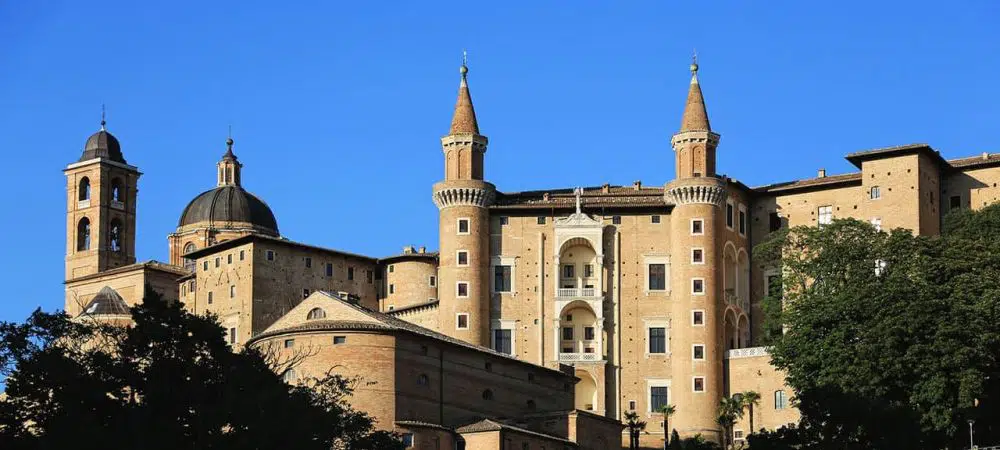
The hilly region of Italy
The Marches, region of central Italy, extends from the Umbria-Marche Apennines to the Adriatic Sea, along the coast for 173 km from the Tavollo stream to the mouth of the Tronto River. It borders to the north with Emilia-Romagna and San Marino, to the west with Tuscany and Umbria, to the south with Lazio and Abruzzo. The territory is divided into 5 provinces with Ancona as the regional capital.
The territory of the Marches
The Marches region is mainly hilly for 69% and does not have large flatlands. The rest of the region is occupied by mountains that rise south to the Sibillini group. In general, the altitude does not exceed 1500 m and on the hilltops dominate wide plain grounds covered by grassy pastures.
The hills
Along the hilly ridges, there are medieval villages and castles with landscapes covered by vines and olive trees. Its coastline, which rises only at San Bartolo (Gabicce) and Conero hills, offers sandy beaches, popular in the summer, villages, and quaint little harbors.
Historical background
Picens, Gauls, and Greeks
The Marches were inhabited by the Picentes since prehistoric times, in a territory that stretched from the river Foglia to Pescara. A civilization that has left rich cultural and archaeological evidence. The 4th century BC sees a new phase of the Picentes civilization. The Gallic population from the French province of Champagne, the Senones, occupy the region north of the Esino river. While the Greeks of Syracuse founded the Ankón colony, today’s Ancona. This city will maintain its Greek culture and appearance for a long time, even after its annexation to the Roman Empire.
The meeting of different cultures
This phase profoundly affects the Picens way of life. Three different cultures (the Celtic, the Picen, and the Greek) find themselves coexisting in a territory where they undergo an evolution with the creation of a Celtic-Greek-Italic agglomeration.
The Western Roman Empire and the Marches
In the third century BC, the Marches region falls under the Romans control. It is strongly Romanized with numerous colonies and centuriations. Two important roads connect the region to Rome: the Flaminia and the Salaria. Under the empire of Augustus, the south of the Marche was annexed to Regio V, called Picenum after the name of the population who lived here before the Roman conquest. While the northern part, called Ager gallicus picenus, is annexed to Regio VI with the eastern territories of Umbria.
Following the administrative reform desired by Diocletian, the two regions are reunited in the Flaminia et Picenum. The territory undergoes a further subdivision under Theodosius I empire.
Early Middle Ages
At the fall of the Western Roman Empire, after brief Goths domination, the Marches region came under the Lombards control who occupied the territory south of Ancona. While the region to the north with the maritime Pentapolis (Ancona, Senigallia, Fano, Pesaro, and Rimini) passes under Byzantiums dominion.
The church and the municipalities period
With the arrival of the Franks, in 754 the whole Marches region was donated by Charlemagne to the church. The term “Marca” appears in the 10th century, under the Ottonian imperial dynasty. According to the German expression, “Mark” indicates a border territory of the Holy Roman Empire. During this historical period, the imperial weakening sees the development of noble powers that will give a significant boost to trade.
Frederick II of Swabia and the Marches
On December 26th 1194, Frederick II of Swabia, the future emperor of the Holy Roman Empire, was born in Jesi. Awarded as Royal City in 1216 with the title of Respublica Aesina by Frederick II, Jesi will retain a certain autonomy during papal domination.
From the Middle Ages to the Renaissance
During the Middle Ages, some powerful noble families emerged such as the Montefeltro, Varano, and Malatesta. The state of the church manages to impose its authority over municipal autonomies and local dynasties. A pressure that proves energetic and effective under the control of Cardinal Gil Álvarez Carrillo de Albornoz (1356) vicar general with extraordinary powers.
Francesco Sforza and Cesare Borgia
From 1433 to 1444 the Marches region saw the affirmation of Francesco Sforza duke of Milan. While at the beginning of the 1500s, the aims of the territory conquest by Cesare Borgia were stopped by Pope Julius II. The action of the church in the Marches ends by incorporating the entire region into the pontificate state with the occupation of Ancona (1532) and the Duchy of Urbino (1631).
From the Papal States to unification
As in much of Italy, the Marches region also experiences a period of recession. With the arrival of French troops, the Marches joined the Roman Republic (1798-99). The subsequent Napoleonic defeat sees the return of the region to the church which will last until 1860, the date of Italian unification.
Art in the Marches
Roman times
In the Marches, there are several Roman traces such as the arch of Augustus in Fano and that of Trajan in Ancona. The only sculptural evidence of the Roman era in the area are the gilded Bronzes from Cartoceto exhibited in Pergola in the province of Pesaro and Urbino.
Romanesque, Gothic and Renaissance
Romanesque architecture (11th-13th centuries) has several churches with Lombard elements that blend with the Byzantine ones. While the Gothic period (XIII-XV century) sees several Venetian influences. But the Renaissance remains the happiest period of the Marches. Starting from the Urbino court, its Doge’s Palace was a crossroads for great artists. The region’s greatest gift to Italian art has been the growth of Bramante and Raphael. The Renaissance was also the best season of the Marches majolica.
